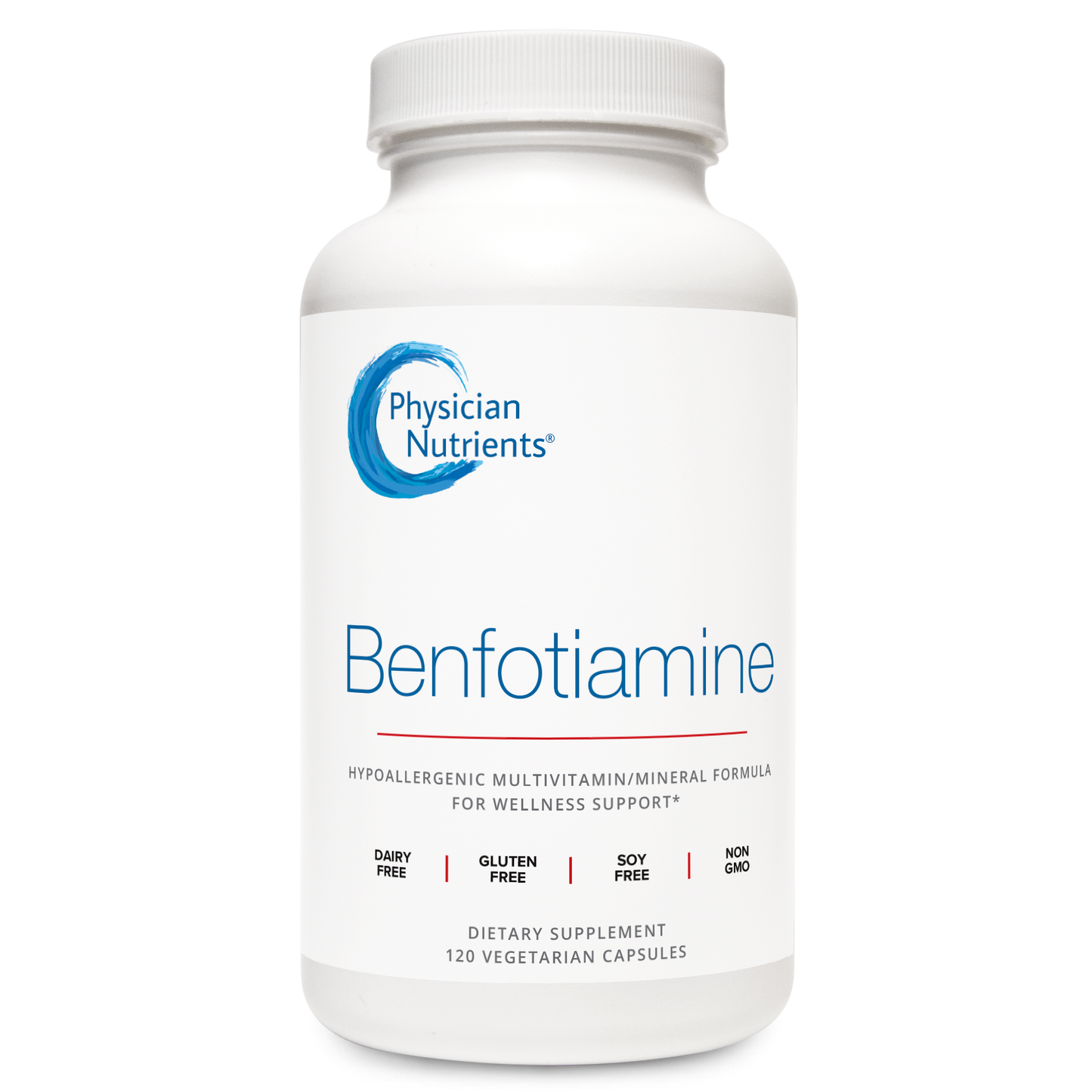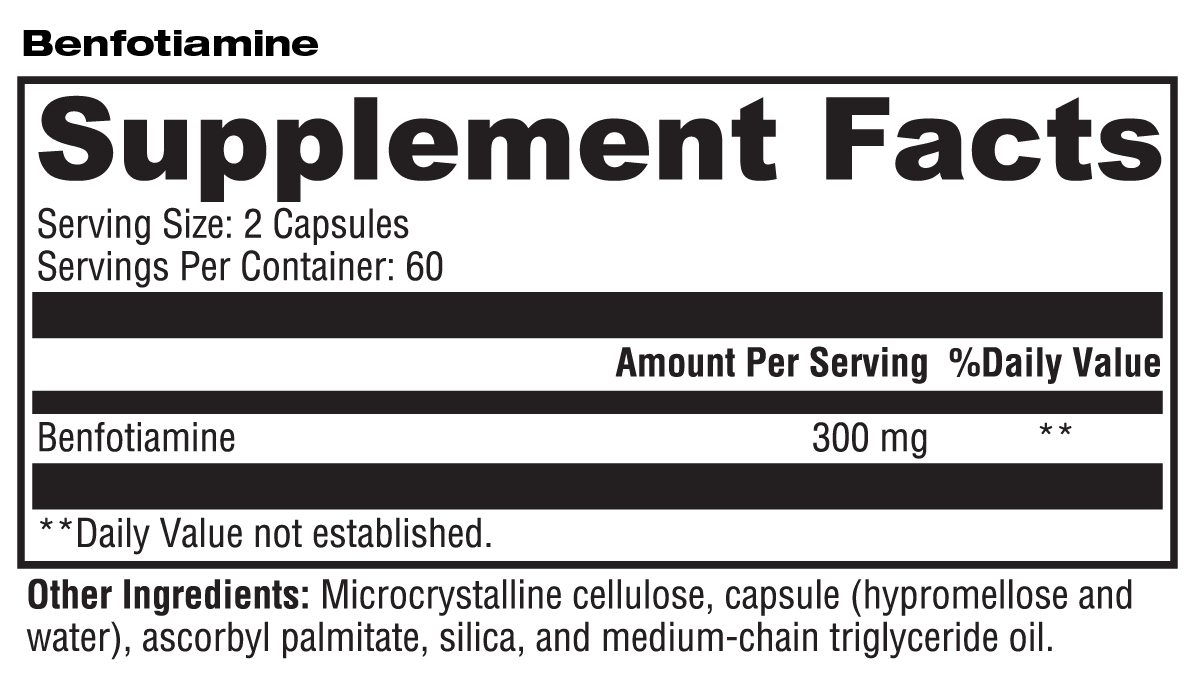Benfotiamine
Benfotiamine
Couldn't load pickup availability
Benfotiamine is a lipid-soluble derivative of thiamin that demonstrates improved absorption and duration of activity compared to water-soluble thiamin. Benfotiamine activates transketolase activity, thereby facilitating conversion of harmful glucose metabolites and positively affecting AGE formation. It supports peripheral nerve health and may support vascular health, including the microvasculature of the retina and kidney. Benfotiamine is also an excellent way to improve thiamin status.*
*These statements have not been evaluated by the Food and Drug Administration. These products are not intended to diagnose, treat, cure, or prevent any disease.
Details
120 Vegetable Capsules
Applications:
Supports Healthy Thiamin Status*
Supports Vascular Health*
Supports Nerve Health*
Directions: Take two capsules in the morning and two capsules in the evening, or as directed by your healthcare practitioner.
Children and pregnant or lactating women should consult their healthcare practitioner prior to use. Do not use if tamper seal is damaged.
Does Not Contain: Wheat, gluten, corn, yeast, soy, animal or dairy products, fish, shellfish, peanuts, tree nuts, egg, ingredients derived from genetically modified organisms (GMOs), artificial colors, artificial sweeteners, or preservatives.
* These statements have not been evaluated by the Food and Drug Administration. This product is not intended to diagnose, treat, cure, or prevent any disease.
Supportive Science
The excellent pharmacokinetic profile of lipid-soluble benfotiamine (S-benzoylthiamine O-monophosphate) is the reason why many practitioners select it in preference to other forms of supplemental thiamin, especially for protocols requiring high levels of the B vitamin. Its effectiveness, however, has been demonstrated even in low doses (i.e. 150 mg/d). As compared to thiamin hydrochloride administration, maximum plasma levels are approximately five times higher and bioavailability is, at maximum, approximately 3.6 times as high. These plasma levels are also better than lipophilic thiamin derivatives.
Pathways of Glucose-Metabolite–Induced Damage: High intracellular sugars can lead to an accumulation of intermediate metabolic products. These metabolic products activate certain pathways. These pathways are: (1) polyol pathway flux; (2) increased formation of AGEs (advanced glycation end-products); (3) increased expression of the receptor for AGEs (RAGEs) and its activating ligands; (4) activation of protein kinase C (PKC) isoforms; and (5) overactivity of the hexosamine pathway. Together, these mechanisms can impact vascular tissue and target particularly susceptible capillary endothelial cells of the retina, mesangial cells in the renal glomerulus, neuronal cells, and Schwann cells.*
Benfotiamine Supports Diversion to Different Pathway: Benfotiamine has been shown to enhance the activity of transketolase, an enzyme that catalyzes the conversion of harmful glucose-intermediate metabolites in the pentose phosphate pathway. In vitro research showed treatment with benfotiamine had an impressive effect on transketolase activity (454% increase from control). Researchers further indicated that increasing transketolase activity supports the diversion of intermediate metabolites away from three of the major pathways (including AGE formation) discussed above. Benfotiamine was shown to have a positive influence on AGE formation and PKC activity. It is thought to prevent NF-kappaB activation in the rat retina as well as inhibit change in the number of retinal acellular capillary segments.*
This research has been supported by a human pilot study wherein subjects given benfotiamine (600 mg/d) plus alpha-lipoic acid (1200 mg/d) demonstrated healthy changes in AGE formation, monocyte hexosaminemodified proteins, and prostacyclin synthase activity.*
Nerve Tissue Health: Microvasculature feeding peripheral nerves can be affected by the pathways discussed herein. Furthermore, lower AGE formation is associated with healthier nerve tissue. The role of benfotiamine in diverting glucose metabolites to a less harmful metabolic pathway may well be the underlying reason it has been used successfully in Germany for over a decade to support nerve health. Results suggest that benfotiamine is most effective in large doses (320-600 mg/d), although effectiveness is still achieved in smaller daily dosages (150 mg/d).
* These statements have not been evaluated by the Food and Drug Administration. This product is not intended to diagnose, treat, cure, or prevent any disease.
Share




